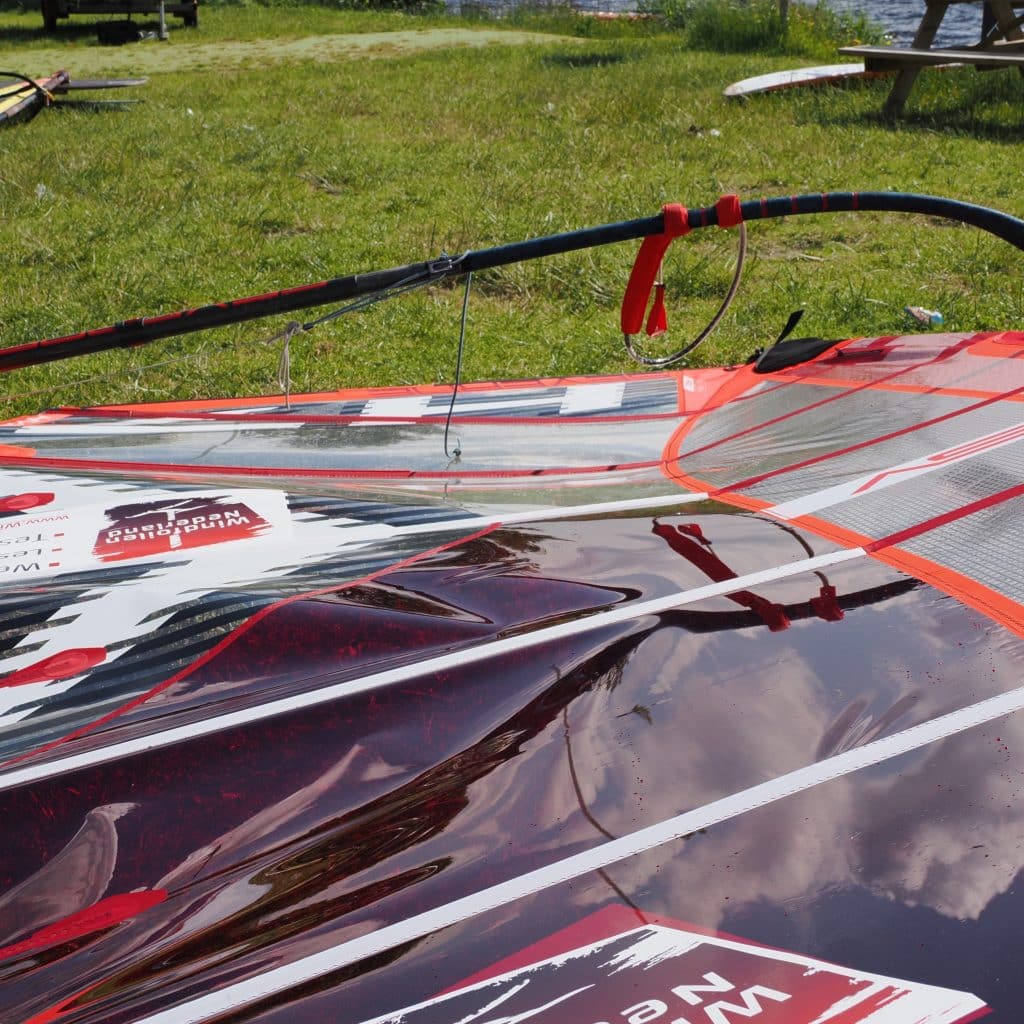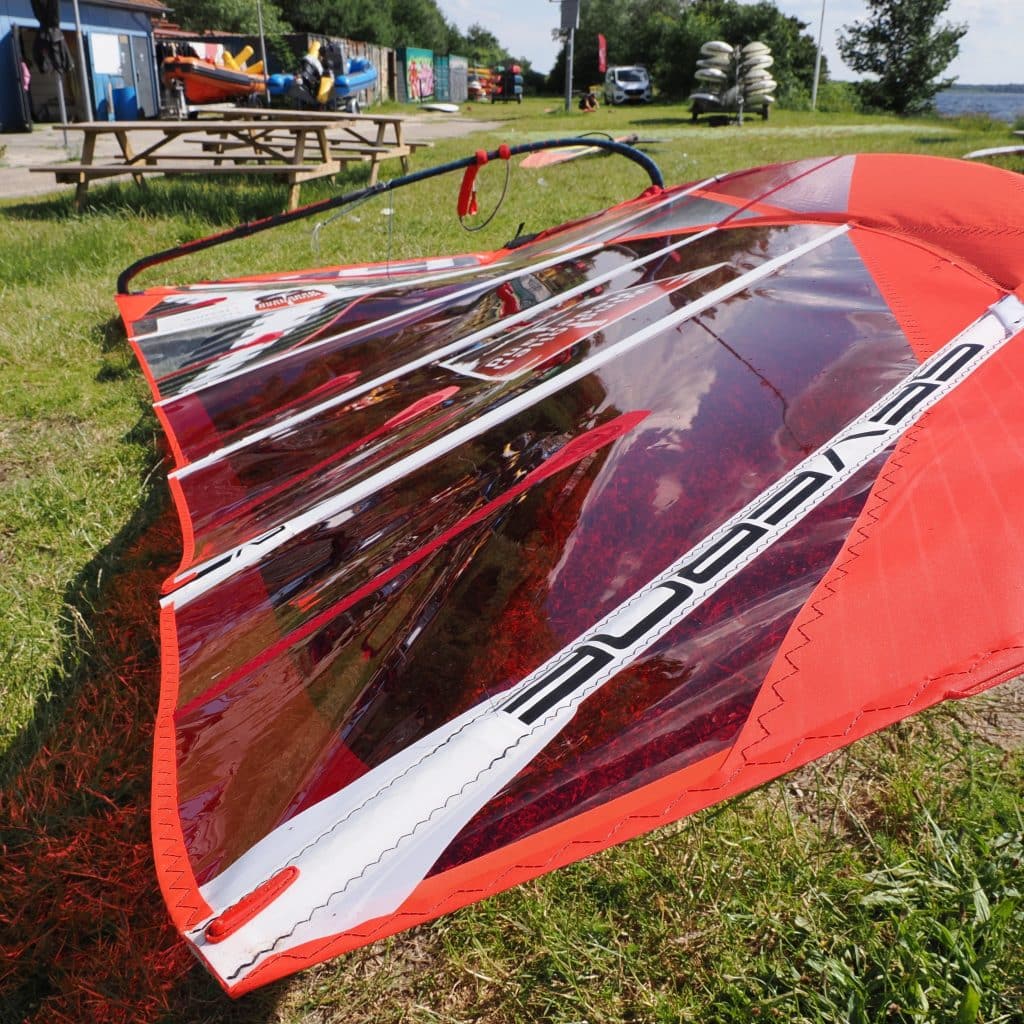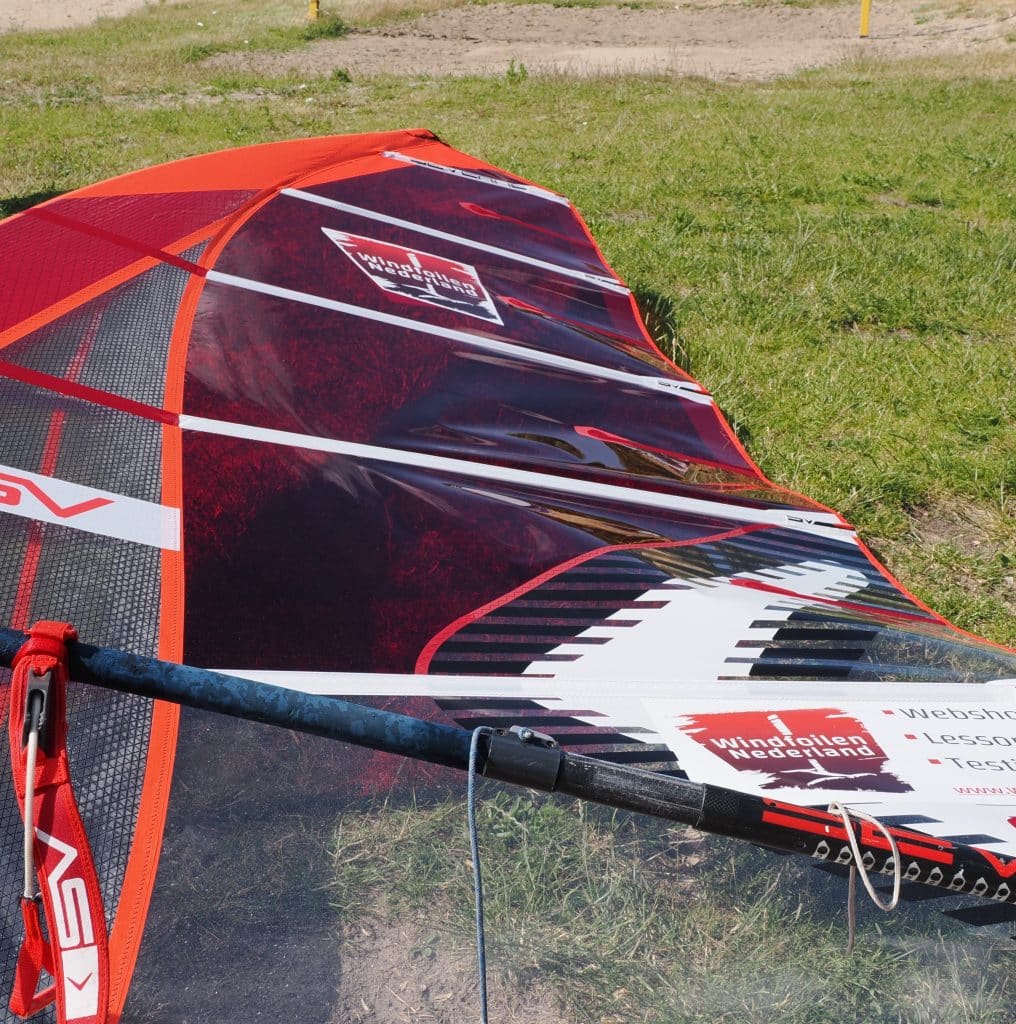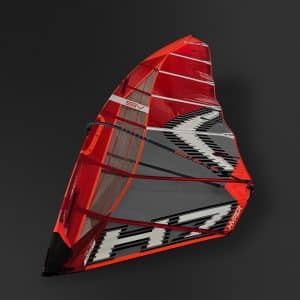We have been sailing the Severne Hyper 7 for a while now. The Hyper is the new name for the well-known HyperGlide. Severne found that “Glide” didn’t quite fit high wind slaloming anymore. Hence, “Glide” is now omitted. It took us a while to get the main sizes right. Read our findings of the Hyper 7 below.
Wind range specific design
Now the 7th generation of foil racing sails from Severne. Starting with Generation 4, the sails are much more optimized for slalom foiling. The Hyper 7 also shifts up again and feels more high-end than the HyperGlide 6. That does depend on size. Often a shape of a sail is translated 1 to 1 across sizes. Severne has now chosen to tailor the design for each size to the wind range/conditions in which that size will be used. According to Severne, all sizes should give less down force and less back hand pressure.
With the largest 2 sizes (8.0m2 and 9.0m2), the emphasis is on good low end performance and getting on the foil quickly. The 7.0m2 is an all-around size with a wide deployment range, and from the 6.0m2 the emphasis is more on top speed and control. So we took the time to thoroughly test out the most popular 3 sizes. The sizes we tested were the 8.0m2, 7.0m2 and the 6.0m2. We test the Hyper 7 paired with the Future Fly Flying Camel 160 and with the Patrik AEON foil.
What is noticeable in all sizes is the increase in luff tension. This is clearly more so than with the Hyperglide 6. Often a greater lower luff tension makes for a more stable sail, but often the sail also becomes somewhat “rigid”. In addition, all sizes also clearly have much more loose leach, the profile is flatter (especially directly behind the mast sleeve) and the bottom of the sail is flatter. The latter ensures that the down force is less.



Effect a lot of down force in a sail?
Without getting very technical now, it is interesting to dwell on what down force does in a sail during windfoiling. First, it causes the downward pressure to increase during wind foiling. The more wind and the harder you go, the more the sail pushes the board down. So the sail is a big part of making sure you can keep the board in the water with the foil.
A sail with a lot of downwind pressure is also prone to pushing the nose down in gusty winds. So that makes it more difficult to windfoil stably and you often feel less confident to push. Reasoning the other way around, a sail that does not give much down force is therefore easier to windfoil stably with gusty winds.
Last but not least. A sail that gives a lot of down force jibes awkwardly. When flipping the cambers, each sail gives temporary a lot of down force. This makes the foiling jibe more difficult and with less control. The less downforce a sail gives, the easier, faster and more controlled you can jibe. In the PWA, the jibes are what races are won (or lost :() very often.
In addition, a sail with less down force also makes it possible to foil with smaller front wings. Smaller wings means less drag and thus better acceleration and higher final speed. These were precisely the concerns in the development of the Hyper 7:
- More stable to windfoil with gusts (prevent nose dips)
- Being able to windfoil faster with smaller front wings
The challenge in designing a sail is to make sure that a sail gives WAY too little down force, but delivers FULL power. Often it is precisely the lower part of the sail (the part below the boom) that gives a sail a lot of power.
Severne Hyper 8.0m2
Despite the greater downhaul tension and more loose leach, this size still feels relatively soft. The sail pumps easily and also gets on the foil quickly. Just to put this sail in perspective. A Severne HGO 8.0m2 or Patrik IQfoil 8,0m2 has a much deeper profile and delivers much more power in low winds and pumps on even easier. So the Hyper 7 8.0m2 is really more high end oriented than the HGO 8.0m2.
Still, with the Flying Camel and the Patrik AEON Foil, we get away just fine at about 10 knots. Indeed, we notice that the sail gives less down force. With the HyperGlide 6, we regularly use the 620 cm2 front wing in the lower wind range with the 8.0m2. Now we use the 550 cm2 front wing in particular.
The foil feel of the Hyper 7 8.0m2 does not feel much different than with the HyperGlide 6 8.0m2. We do notice that the back hand pressure is less. This makes the sail feel lighter while windfoiling. With gusty winds and with harder winds, this size does feel more stable than the previous generation. The power of this sail is in the upper half of the wind range up to about 13 to 14 knots. At this size, it is the details that make the Hyper 7 a better sail over the Hyperglide 6.
Severne Hyper 7.0m2
Of the sizes tested, we think the 7.0m2 is the most all-around. The 7.0m2 doesn’t feel as “soft” as the 8.0m2 but still delivers enough pressure to foil easily in low wind conditions. The deployment range of this sail for us (around 80 kg) is between 12 and 18 knots. In which the performance of this sail from about 14 knots is very good. The more wind, the more controlled and stable this sail feels. In the higher wind range, this sail is a lot better than the previous generation.
We use with this size the Patrik AOEN 450 cm2 front wing or in the higher wind range the smaller size 400 cm2.
Severne Hyper 6.0m2
This size feels very small. The mast length is also about 20 cm shorter compared to the Hyperglide 6 while the boom length has remained more or less the same. Is the sail even a 6.0m2? This size feels noticeably less soft than the larger sizes.
We find that we need quite a bit of wind to have enough power to get on the foil and push. You do need 16 to 17 knots with this sail to really get along. Especially since with this size you are using a maximum front wing of about 400 cm2.
What is noticeable is that the 6.0m2 seems to give (even) less down force than the sizes mentioned above. We have foiled this sail with the 450 cm2 front wing, but then we find that we actually have too much elevator continuously. With the 400 cm2 the set up feels very well balanced and we can keep this size for a very long time
If you have enough wind, this sail actually flies well. Extremely stable too. We can effortlessly use this size up to about 22 to 24 knots. The Hyperglide 6 6.0m2 felt a bit nervous in gusty winds and had a strong tendency to push the nose of the board down. The Hyper 7 in this size suffers much less from that. That makes this sail much easier to push and control. If the wind dips too much, you will be quickly underpowered with this size.
Wrap up, the smaller the size the bigger the differences
The title actually says it all. The 8.0m2 is a fine sail and the improvement is h’m in the details of the sail. Main improvement is that the sail feels lighter, especially in overpowered conditions.
In the smaller sizes, we find the differences greater, with the control and stability of the sails in particular improving.
It is also evident that the smaller the size the more high end and stable the sails feel. However, you do clearly sacrifice in terms of low end performance.
We think the sizes 7.0m2 and larger are also very suitable for the average freeracer. The 6.0m2 and smaller are more high end and therefore less suitable for the average freeracer we think.
-
Sale!

Severne Hyper 7 foil race
€999,00 – €1.169,00 incl. VAT Select options This product has multiple variants. The options may be chosen on the product page


